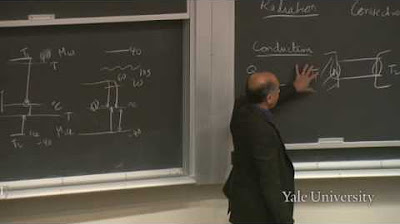Convert Celsius & Fahrenheit Temperature Scales in Chemistry & Physics - [1-1-4]
TLDRThis chemistry tutorial delves into the fundamental concepts of temperature and density, their definitions, and relevance in everyday life and chemistry. It explains that temperature is a measure of a substance's internal energy, with higher temperatures indicating more vigorous atomic and molecular motion. The video introduces the Celsius scale as the primary temperature scale in chemistry, with 0°C defined as the freezing point and 100°C as the boiling point of water. It also touches on the Fahrenheit scale, highlighting its less scientific nature due to its arbitrary points of 32°F and 212°F. The importance of understanding temperature conversions between Celsius and Fahrenheit is emphasized, using the formula F = 1.8 * C + 32. The video concludes with a brief mention of the Kelvin scale, which is used in more advanced chemistry and represents absolute zero as 0 K. The tutorial underscores the significance of temperature in chemical reactions, noting that most reactions accelerate with heat and slow down with cold.
Takeaways
- 🔥 **Temperature is a Measure of Energy**: Higher temperature indicates more internal energy within a substance due to increased molecular motion.
- 🌡️ **Understanding Temperature Scales**: The Celsius scale is commonly used in chemistry with 0°C as the freezing point and 100°C as the boiling point of water.
- 📉 **Differentiating Celsius and Fahrenheit**: Celsius is more convenient for scientific calculations, while Fahrenheit is used in some regions like the United States but is less straightforward for conversions.
- ➡️ **Conversion Equations**: To convert between Celsius and Fahrenheit, use the equation F = 1.8 * C + 32, and to convert from Fahrenheit to Celsius, use C = (F - 32) / 1.8.
- ❄️ **Absolute Zero and the Kelvin Scale**: The Kelvin scale is used in scientific contexts and defines 0 K as the point where all molecular motion stops, known as absolute zero.
- 🌟 **Practicality of Celsius**: The Celsius scale is preferred for scientific use due to its simplicity and direct correlation with the properties of water.
- 📚 **Historical Context of Fahrenheit**: The Fahrenheit scale has historical significance and is based on arbitrary points for the freezing and boiling points of water.
- 🔄 **Effect of Temperature on Reactions**: Chemical reactions are generally faster at higher temperatures and slower at lower temperatures due to the impact of energy on molecular motion.
- 🌌 **Extremes of Temperature**: Even in the cold depths of space, temperatures do not reach absolute zero, which is a theoretical limit.
- 🛠️ **Importance of Temperature in Chemistry**: Temperature is a fundamental concept in chemistry, affecting nearly all chemical reactions and processes.
- 🧠 **Understanding is Key**: Grasping the concept of temperature and how to work with different temperature scales is essential for success in chemistry.
Q & A
What is the basic concept of temperature?
-Temperature is a measure of the internal energy of a substance, which is related to the kinetic energy of motion of the atoms and molecules within that material. Higher temperature indicates more internal energy and more vigorous vibration of the atoms and molecules.
Why does a hot object burn when touched?
-A hot object burns when touched because the energy of motion (kinetic energy) within the object is transferred to your hand. This energy transfer can damage tissues due to the increased motion at a microscopic level.
How is the Celsius temperature scale defined?
-The Celsius temperature scale is defined such that 0 degrees Celsius is the freezing point of water and 100 degrees Celsius is the boiling point of water under standard atmospheric pressure.
What is the main difference between the Celsius and Fahrenheit scales?
-The Celsius scale is based on the freezing and boiling points of water, with 0 degrees being the freezing point and 100 degrees being the boiling point. The Fahrenheit scale, on the other hand, has 32 degrees as the freezing point and 212 degrees as the boiling point of water. The scales are set up differently, making direct conversion between them complex without using an equation.
What is the conversion equation between Celsius and Fahrenheit?
-The conversion equation between Celsius and Fahrenheit is: Fahrenheit = (1.8 × Celsius) + 32.
Why is the Kelvin scale important in chemistry?
-The Kelvin scale is important in chemistry because it is an absolute temperature scale where 0 Kelvin represents absolute zero, the theoretical point at which all atomic motion stops. It is used in scientific calculations and thermodynamics.
What is the relationship between temperature and chemical reactions?
-The rate of most chemical reactions is dependent on temperature. Generally, increasing the temperature causes the reaction to proceed more rapidly, while decreasing the temperature slows down the reaction.
How does the Fahrenheit scale compare to the Celsius scale in terms of convenience for scientific use?
-The Celsius scale is more convenient for scientific use because it has round, easily understandable numbers for the freezing and boiling points of water. The Fahrenheit scale uses 32 and 212 degrees, which are not as straightforward and are less preferred in scientific contexts.
Why is the boiling point of water different at various altitudes?
-The boiling point of water is different at various altitudes due to the change in atmospheric pressure. At higher altitudes, the atmospheric pressure is lower, which causes water to boil at temperatures lower than 100 degrees Celsius.
What is the significance of absolute zero in the Kelvin scale?
-Absolute zero, which is 0 Kelvin, is significant because it is the theoretical temperature at which all molecular motion ceases. It represents the lowest possible temperature and is a fundamental concept in thermodynamics.
How can one convert 75 degrees Fahrenheit to Celsius?
-To convert 75 degrees Fahrenheit to Celsius, you would use the equation: Celsius = (Fahrenheit - 32) / 1.8. Plugging in 75 gives you Celsius = (75 - 32) / 1.8, which equals approximately 24 degrees Celsius.
Why is it important to understand temperature scales in chemistry?
-Understanding temperature scales is important in chemistry because temperature is a critical factor in many chemical reactions and processes. Accurate measurement and conversion between different scales are necessary for proper scientific communication and experimentation.
Outlines
🔥 Understanding Temperature and Its Effects
The first paragraph introduces the topic of temperature and its importance in chemistry and everyday life. It explains that temperature is a measure of the internal energy of a substance, directly related to the kinetic energy of motion of the atoms and molecules within it. The higher the temperature, the more vigorous the motion and the higher the energy content. The concept is illustrated with examples of how hot and cold objects can cause harm due to the transfer of energy. The Celsius temperature scale is introduced, with 0 degrees Celsius defined as the freezing point of water and 100 degrees Celsius as the boiling point, making it a convenient scale for scientific use.
🌡️ Celsius, Fahrenheit, and the Science of Temperature Scales
The second paragraph delves into the practicality of the Celsius scale in chemistry and acknowledges the existence of the Fahrenheit scale, which is less common in scientific contexts but still relevant for historical and regional reasons. The challenges of converting between these two scales are discussed, as they are not based on a simple linear conversion due to the different zero points (freezing point of water). The direct conversion formula between Fahrenheit and Celsius is provided, along with examples to demonstrate its use. The paragraph emphasizes the mathematical convenience of the Celsius scale and briefly touches on the historical reasons behind the specific values chosen for the Fahrenheit scale.
🌟 Converting Temperatures: Celsius to Fahrenheit and Vice Versa
This paragraph provides a practical guide on converting temperatures between Celsius and Fahrenheit using the previously mentioned formula. It walks through the process of converting 10 degrees Celsius to Fahrenheit, resulting in 50 degrees Fahrenheit, and then reverses the process by converting 75 degrees Fahrenheit back to Celsius, yielding approximately 24 degrees Celsius. The importance of understanding these conversions is highlighted, especially for those in regions where Fahrenheit is commonly used. The discussion also sets the stage for introducing the Kelvin scale, which is used in more advanced chemistry topics.
❄️ The Kelvin Scale and Absolute Zero
The final paragraph touches on the Kelvin temperature scale, which is used in more advanced chemistry contexts. It explains that zero Kelvin represents absolute zero, the theoretical point at which all atomic motion ceases. The paragraph emphasizes that while nothing in nature actually reaches zero Kelvin, some substances can get extremely close, like liquid helium at around four Kelvin. The importance of understanding the Kelvin scale is mentioned in the context of chemical reactions, which often depend on temperature. The paragraph concludes with a reminder of the importance of grasping the concept of temperature for future studies in chemistry.
Mindmap
Keywords
💡Density
💡Temperature
💡Internal Energy
💡Kinetic Energy
💡Celsius Scale
💡Fahrenheit Scale
💡Conversion Factor
💡Kelvin Scale
💡Absolute Zero
💡Chemical Reactions
💡Thermometer
Highlights
Temperature is a measure of the internal energy of a substance, directly related to the kinetic energy of motion of the atoms and molecules within it.
Higher temperature indicates more vigorous vibration of atoms and molecules, which can lead to tissue damage upon contact.
The Celsius scale is convenient in chemistry, with 0°C defined as the freezing point of water and 100°C as the boiling point.
The Fahrenheit scale, while used in the United States, is less convenient for scientific purposes due to its arbitrary nature.
The conversion between Celsius and Fahrenheit is not straightforward and requires a specific equation: F = 1.8 * C + 32.
Zero degrees Celsius is equivalent to 32 degrees Fahrenheit, and 100 degrees Celsius is equivalent to 212 degrees Fahrenheit.
The Kelvin scale represents absolute temperature, with 0 K indicating that all atomic motion stops.
The Kelvin scale is used in scientific contexts, but Celsius is more commonly used in chemistry for its simplicity and everyday relevance.
Chemical reactions are generally dependent on temperature, with higher temperatures accelerating reactions and lower temperatures slowing them down.
Understanding temperature and its scales is fundamental to grasping the principles behind chemical reactions and processes.
The Celsius scale is particularly useful because it has clear, everyday reference points for freezing and boiling points of water.
The Fahrenheit scale's freezing and boiling points of water are 32°F and 212°F, respectively, which are not as intuitive as the Celsius scale's 0°C and 100°C.
When converting temperatures, it's important to know the direction of conversion and apply the correct mathematical operations.
The history behind the Fahrenheit scale's values is less relevant to modern scientific understanding, which favors the Celsius and Kelvin scales.
The Kelvin scale is based on absolute zero, a theoretical point at which all molecular motion ceases.
The conversion between Kelvin and Celsius is straightforward, as they are related by a constant increment, unlike the Celsius to Fahrenheit conversion.
The understanding of temperature scales is crucial for anyone studying chemistry, as it underpins many chemical principles and calculations.
Transcripts
5.0 / 5 (0 votes)
Thanks for rating:





